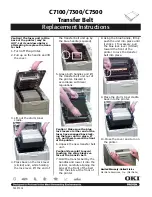
7
Modeling Light:
The modeling light has two modes of operation:
1. With
POWER
switch in
MODEL/FLASH
upper position, the modeling
lamp is ON.
2. With
POWER
switch in
FLASH
or center position, the modeling lamp is
OFF.
[Note: With battery models the modeling lamp is disabled to conserve the
available battery power.]
Test Function:
The
TEST
button is pressed to fire the flashtube for test purposes.
Power Off:
Turning OFF the POWER switch will turn OFF both the AC line power and
the battery pack power connection. The POWER switch must be ON for
either power source. The battery pack will also have a POWER switch,
which must be turned ON and OFF.
The StudioMax III POWER OFF position will “dump” the stored power in the
flash capacitors by flashing the unit. This is for safety and reliability.
Synchronization and Triggering:
Triggering is accomplished by using a camera flash or a trigger cable from
one StudioMax III to the camera shutter contacts of ”X” or “zero” delay.
Other units in the system are then triggered by built-in photoslave
operation, or a “daisy-chain” connection of all SYNC jacks. It is best to
connect the fill light directly to the camera since it will be positioned furthest
back in the studio and will usually provide sufficient illumination to trigger
the other units. It is suggested that all walls and ceiling be painted either in
white or light neutral colors for most reliable photoslave operation.
After the trigger cord is properly connected, check the synchronization with
the camera. Adjust the lighting unit to same height as the camera lens and
face the lights into the lens. The lens aperture should be open to its fullest
extent and set on “X” or “zero” delay. Remove the camera back. It is best
to perform this test with the modeling lamps turned off.
While looking at the lens through the back of the camera, operate the
shutter. A few sheets of white paper in front of the lens will cut down the
brilliance of the flash and aid in making the observation. The flash of the
light should then appear as a circle the same size as the aperture. If the
circle is flattened on the sides, or if no light appears through the lens, the
shutter is not synchronized. If the shutter appears not to be synchronized,
a reputable camera repair shop should check the shutter contacts.


































